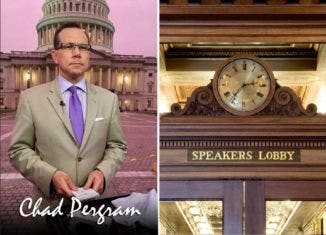Debt Ceiling Sabermetrics
The debt limit debate is fundamentally about numbers.
For starters, there’s $14.3 trillion. That’s the current, statutory debt ceiling which the federal government is threatening to blow past on August 2.
Then there’s $2.4 trillion. That’s the potential figure by which experts believe Congress would have to increase the debt limit to get the government through the end of 2012. That also seems to be the total cost of spending cuts or revenue offsets that could be negotiated in any final debt limit agreement.
Finally there’s $4 trillion. That’s the amount of the broad, deficit reduction plan floated by President Obama late last week. House Speaker John Boehner (R-OH) yanked that proposal off the table Saturday night after witnessing ferocious opposition from House Democrats.
Those are the most-common figures people are batting around in this debt ceiling debate. But there’s another set of near-Pythagorean numbers which could be more important to the debt limit. Understanding the Realpolitik behind these numbers explains the practical political calculus which makes it so complex to broker a debt ceiling agreement.
Call this the “Sabermetrics” of the debt ceiling.
Baseball statistician Bill James popularized Sabermetrics to better understand the “true” value of Major League Baseball players. In other words, are superstars like Derek Jeter and Ryan Howard really as good as conventional statistics tell us they are? Do they get clutch hits? How’s their defense? Sabermetrics offers unique numerical yardsticks to help measure performance beyond ERA’s and stolen bases. One calculation is known as WAR. It stands for Wins Above Replacement player. It helps determine how many more wins a certain player is capable of producing for his team over a garden-variety player.
The raw economic numbers of the debt and potential savings akin to home runs and doubles. But like baseball’s WAR, there are hidden denominators which can help quantify the challenge of moving a debt ceiling deal through Congress.
So, some Sabermetric numbers of the debt ceiling….
“217”
“We need 218 votes,” said House Majority Leader Eric Cantor (R-VA) as he left the Capitol for Sunday’s debt talks at the White House.
218 is usually the figure needed to approve measures in the House. 218 represents one more than half of 435, the total size of the House of Representatives. Good vote counters like Cantor automatically calculate “218” as the magic number for passage in the House. And in Cantor’s defense, “218” is the colloquial phrase in Washington for victory in the House. But for the debt ceiling exercise, the important number is really 217.
To wit: By August 2nd, the House is likely to have just two vacancies. There are open seats once occupied by former-Rep. Anthony Weiner (D-NY) and now-Sen. Dean Heller (R-NV). At this moment, a seat held by former-Rep. Jane Harman (D-CA) remains unfilled. But there’s a special election there Tuesday to succeed Harman. So that seat will soon be filled.
Rep. Gabrielle Giffords (D-AZ) is not voting.
Therefore, the maximum number of votes in the House is 432. 217 is one more than half. So 217 is the minimum number required to approve any debt ceiling agreement.
“80-120”
The next “number” is actually a range. 80-120 is the number of House Republicans who handicappers believe wouldn’t vote for a debt limit increase, no matter what.
For starters, the House Republican Conference has 240 members. Losing 80 to120 is a staggering chunk. That explains why it’s hard to forge a deal that garners substantial Republican support.
“Boehner has two factions in his caucus,” said Rep. Peter Welch (D-VT) on GOP prospects for passing the debt ceiling. “There’s ‘no’ and there’s ‘hell no.’”
Many conservatives with tea party backing fundamentally oppose increasing the debt ceiling.
Rep. Gerry Connolly (D-VA) adds that some Republicans, like GOP presidential contender Rep. Michele Bachmann (R-MN), said they won’t raise the debt limit “on dogma” as he calls it.
“I would argue there would be fewer Republicans who would vote for this than the CR,” said Connolly of the bill that averted a government shutdown in April.
“CR” is Congressional short-hand for “Continuing Resolution,” a stopgap measure used to keep the government operating.
“57-97”
The next set of numbers is also a range, but on the Democratic side of the aisle. If Republicans lose 80-120 of their members, Democrats would be asked to provide anywhere from 57 to 97 of their 192 members to put a debt ceiling deal over the top.
“Traditionally it’s always been up to the president and his party to raise the debt limit,” said Cantor Sunday.
“That is going to be a tall order,” said Gerry Connolly about the prospects of Democrats contributing votes to a final deal.
Interestingly, the “97” number presents an important threshold in this application. In June, the House engineered what many regarded as a “moot” vote to increase the debt ceiling. The bill was stripped bare of any savings or spending cuts. It was just a straight up or down vote. The House defeated the package 318 to 97. All 97 members who voted yes were Democrats.
“59”
Like the digit “97,” the next important number in Congressional algebra also emanates from a key House vote earlier this year.
Fifty-nine was the number of House Republicans who bucked GOP leadership in mid-April and voted against the final bill to slash $61 billion in spending and keep the government open for business.
The House okayed the bill 260-167. But losing 59 Republicans meant the GOP majority needed the assistance of 81 Democrats to adopt the package. Many of those who voted no were freshmen or conservative lawmakers with tea party loyalties. In any debt ceiling deal, Boehner, along with the president, must finagle significant Democratic buy-in. Such support was evidently not there late last week when President Obama floated the idea of a “grand bargain” that sliced $4 trillion and restructured Medicare, Medicaid and Social Security.
A Republican source familiar with the talks said that Boehner realized there was “no path” to the broader deal, so he yanked it off the table.
“Speaker Boehner could not get the votes in his House Republican Conference,” declared Democratic Vice Caucus Chairman Xavier Becerra (D-CA) of Boehner’s decision on FOX News Sunday. But the real problem was the internecine conflagration among Democrats over entitlements.
The president proposed using a government calculation called the “Chained CPI” to determine benefit levels for Social Security recipients. The Chained CPI is calculation based on consumer costs.
But many Democrats met Mr. Obama’s idea with a rhetorical flamethrower.
“Chained CPI is a fancy word for ‘we’re going to cut your benefits,’” said Rep. Nita Lowey (D-NY).
Rather than immediately board trains and planes to head home to their districts late last week, many Democrats remained at the Capitol for a special meeting of the House Democratic Caucus. It was that session which ultimately spelled doom for the president’s entitlement proposal.
“Let me just say their enthusiasm was such that many of them stayed around after votes to participate in this caucus,” said House Minority Leader Nancy Pelosi (D-CA) of her fellow Democrats. “(It was) almost unheard of. But they did on a Friday afternoon.”
Pelosi noted that “high-tension wires” go up when talking about changes to entitlements unless someone “can justify the changes.”
And apparently no one successfully made the case.
“228-205”
On September 29, 2007, the House embarked on one of the most-suspenseful votes in its history. The country stood on the precipice of an economic meltdown. So the Bush Administration concocted a plan to rescue embattled financial institutions. The bill would create TARP, the “Troubled Asset Relief Program.”
Democrats believed House Republicans could deliver 80 to 100 votes to compliment the 140 Democrats who ultimately voted for the bill. But in the end, only 65 Republicans voted yes and the bill tanked, 228 to 205.
The Dow then dipped into a frantic tailspin, tumbling 777 points. It marked the largest-single point drop ever.
In that instance, Democrats were in the majority in the House. But the Bush White House couldn’t even drum-up the necessary GOP votes to help pass the bill.
The legislation returned to the floor a few days later. After witnessing the Dow crater, the House approved the so-called “bailout” bill 263-171. Democrats only had 172 yeas, not enough for a majority. But they were joined by 91 House Republicans.
The challenge with the debt ceiling is authoring an agreement capable of securing the precise mix of Democrats and Republicans to reach “217.” Many lawmakers remain spooked from the TARP experience and can’t stomach a repeat.
“3”
TARP ushered in a new era on Capitol Hill, that of the “nation-swings-in-the-balance brinksmanship vote.” The TARP vote was the first of this trio in the fall of 2008. The vote to sidestep a government shutdown this spring was the second. The debt ceiling could be number three.
Why is Congress suddenly saddled with these repeated dramatic votes?
Part of it is the sheer dimension and echoes of the 2008 economic downturn. In response to the flailing economy, President Obama crafted the $700 billion stimulus plan to fix the economy. Results of the stimulus are mixed at best. By the same token, the stimulus and TARP piled colossal debt onto an already towering deficit. Such profligate spending and mounting debt then fueled the tea party movement and the GOP’s success in the midterm election.
That brings us to this fundamental point with the debt ceiling.
TARP was hard. The CR to keep the government shutdown was tougher. And Boehner tells his GOP colleagues the debt ceiling is going to be harder still.
During his string of debt ceiling talks at the Capitol, Vice President Biden was confident that leaders could frame an arrangement that would pass.
“We’re being honest in (our assessments) to one another,” Biden said of the negotiators. “‘This is as much as the traffic will bear on my street. Well, this is as much as the traffic will bear on my street.’”
The problem is that the political streets which criss-cross Capitol Hill don’t appear to be capable of handling the necessary legislative traffic to approve a debt ceiling increase. Finding that balance represents the Sabermetrics behind the debt limit. It’s a bewildering equation that has stumped negotiators for months.
“10”
At the beginning of Sunday night’s meeting, a reporter asked the president “Can you work it out in ten days?”
The president simply replied “We need to.”
And ten days is about all the president and Congressional negotiators have left to avoid an unprecedented federal default. And that doesn’t matter if you’re using conventional statistics or Congressional Sabermetrics.

